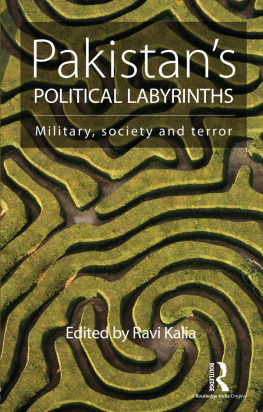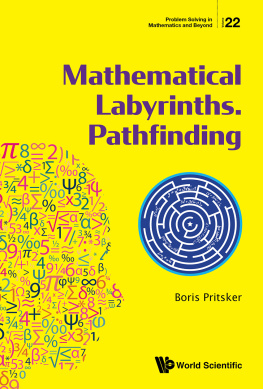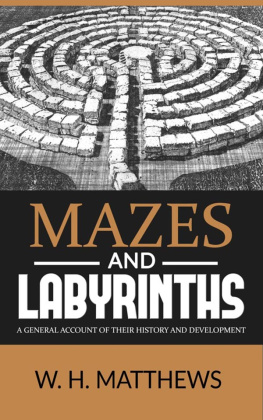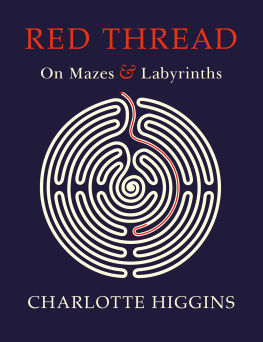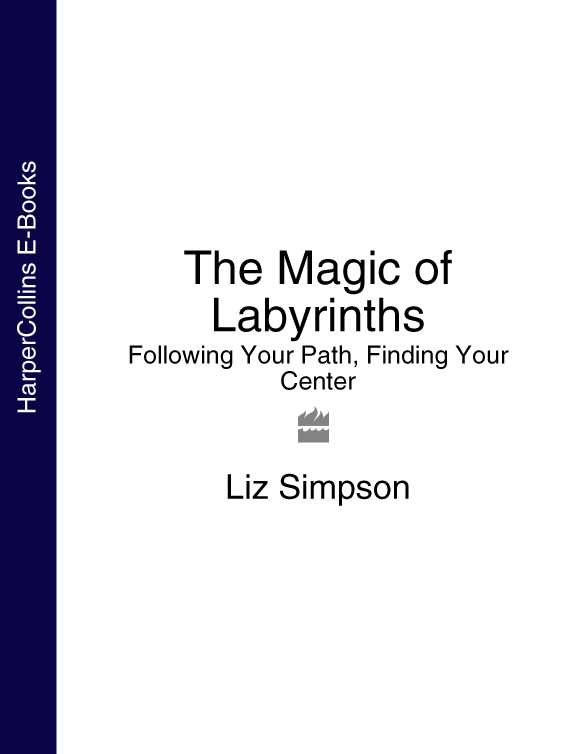
A s a wise woman once remarked to me, the labyrinth is not about me, its about us. The same is true of books. I could not have written this one without the generosity of spirit I received from so many inspiring individuals. Their support and the openness with which they shared their personal stories and wisdom have helped make the writing of this book an especially joyous experience for me. I would therefore like to extend my special thanks to:
Kim Anderson
Neil Anderson
Jim Buchanan
Dr. Alex Champion
Joan Champion
Kathy Doore
Robert Ferr
Lea Goode-Harris
Nicholas Halpin
Joyce Leake
Prof. Paula Lemmon
Sig Lonegren
Rae Ann Kumelos Mahon
Marge McCarthy
Julie Mitchell
Joseph Rafalo
Taylor Ray
Jeff Saward
Dr. Lynne A. Texter
Calvin Vanderhoof
Dale Vanderhoof
I would like to dedicate this book to my husband, Douglas Barnes. There is a saying Im fond of: A mind once stretched by a new idea never goes back to its original dimensions. No one has ever stretched me as much as you, Doug, for which I am ever grateful.
A walking meditation, a spiritual tool,
a means of coming to ones spiritual center.
Viewed from exterior angles, a device that appears complicated and bewildering but, once experienced, is found to be a single pathway (unicursal) that winds inextricably towards its center and requires you simply to take the same route out.
delirium, delusion, disappointment.
A network of interconnecting passages designed for trickery and deception. A complex puzzle that, without guidance, is difficult or impossible to navigate to a successful conclusion.
Instead of searching for what you do not have, Find out what it is you have never lost.
SRI NISARGADATTA MAHARAJ (1897-1981), FROM I AM THAT
W hat is a labyrinth? How does it differ from a maze? And why are so many people across the world today embracing a symbol that is thousands of years old? It is these, and other questions, that this book aims to address but as a guidebook, rather than a set of rigid rules that have to be followed. Because what is so exciting about labyrinths is that they lend themselves to individual interpretation. There is no single labyrinth pattern, nor is there a right or wrong way to walk a labyrinth. Each experience is unique and, if welcomed, can offer valuable insights about how to navigate life and address its challenges.
The beauty of the labyrinth motif is that its appeal is so multi-faceted. As a metaphor for lifes journey, the labyrinth prompts us to think about the way we choose to travel that path whether we savor each moment, secure in the belief that while lifes problems will continue to challenge us, we have the inner resources and confidence to solve them. Or whether we act like distracted onlookers always wondering why someone else seems to have the better deal. Consciously walking the labyrinth can cause you to reflect on whether life is something that just happens to you, or is an experience that you choose to truly engage with. The labyrinth symbol can help you re-appraise your goals in life to stop looking for a quick fix by latching onto this guru or that and to accept full responsibility for your own spiritual enlightenment. After embracing the labyrinth as a metaphor for journeying into our deeper, hidden, authentic selves, many have been inspired to recognize that the source of contentment and wisdom lies within. Since walking the labyrinth consciously and with respect has prompted others to ask themselves questions like these, then it is likely to do the same for you. The labyrinth is not just a philosophical tool but lends itself to many practical applications. Here are a few of the ways in which labyrinth symbolism can be integrated into your life:
as a form of walking meditation, particularly for people who find it hard to sit still;
to relax and release stress;
to stimulate creative thinking and problem-solving;
to assist in focusing on your breath;
to work with your chakra system and the flow of chi;
to get in touch with your inner or higher self;
to connect with the Earth and more fully appreciate your environment;
to create a stillness in which you can hear the whisper of your intuition;
to do something nice for yourself by yourself;
to illustrate that you alone are responsible for the path you chart through life;
to reconnect you to the Hero within.
If you are challenged in any of these areas or if you are seeking a more grounded and balanced life, then there will undoubtedly be something within these pages that will arouse your interest and help you find new ways to approach these challenges and help you achieve your goals.
The Magic of Labyrinths is comparable to a journey. Like the labyrinth, while there is a commencement there is no definitive ending. That is entirely consistent with the nature of self-discovery. There are always more questions, more adventures and more lessons to participate in. We are spiritual students who, once committed to the journey, discover what it takes to be the most accomplished human graduates we can be. Within these pages you will be encouraged to re-examine your attitude to the challenging, complex and frequently perplexing pathway of life. A pathway that does not have to be a maze-like puzzle full of dead ends and frustrations, but a single route to an inevitable and glorious goal self-mastery.
Indeed, of all the methods of self-understanding that I have introduced to friends, coaching clients and others, employing the labyrinth symbol as a walking, finger or doodling meditation has never failed to elicit powerful insights with which they have claimed a richly rewarding life. What specifically will you discover about labyrinths in this book and how can you apply them to your life? Here is a brief overview.
In Chapter One we will establish the historical contexts in which the labyrinth symbol emerged and was disseminated. Our journey takes us from stone-age Siberia, through Roman and Medieval times to the present day. We will travel through time from Egypt and Mauritania in Africa to picturesque villages in Britain and Scandinavia. You will read how the labyrinth symbol impacted Roman youths and Welsh shepherd boys, Native American tribes people and contemporary Latin scholars. And you will learn how pagan traditions were blended with the Christian Churchs faith, explaining why so many labyrinths were established on the walls and floors of medieval cathedrals throughout France, Italy, and Britain.
Chapter Two looks more closely at how the various labyrinth patterns developed the Classical Cretan motif, the medieval Christian and Roman mosaics, as well as new, contemporary versions. Once again, our journey together will take us across time and space to explore the labyrinths and other wheel-like symbols of Ireland, Peru, the United States, and Tibet, in addition to the palace of the legendary King Minos in Crete, the setting for the mythical tale of Theseus and the Minotaur. Our adventure will take in the significance of shape and numbers, place and energy. By which time you will have an appreciation of how the site of labyrinths is just as important as their size or design.
Throughout Chapter Three we journey inwards. By exploring the myth of Theseus and the Minotaur we determine the difference between a maze and a labyrinth and how we allow our minds to react to life as a diabolical puzzle or a direct, albeit circuitous, route to our goals. In particular, we will look at different ways in which the labyrinth experience can facilitate a paradigm shift in your approach to life, expanding on four themes which relate to the Heros journey The Call to Change, the Trial, Facing up to Doubt and Rebirth or resurrection. You will find out how the Heros journey is a common theme woven by storytellers from Homer to Hollywood and what it means to be a Hero in your own life.
Next page


